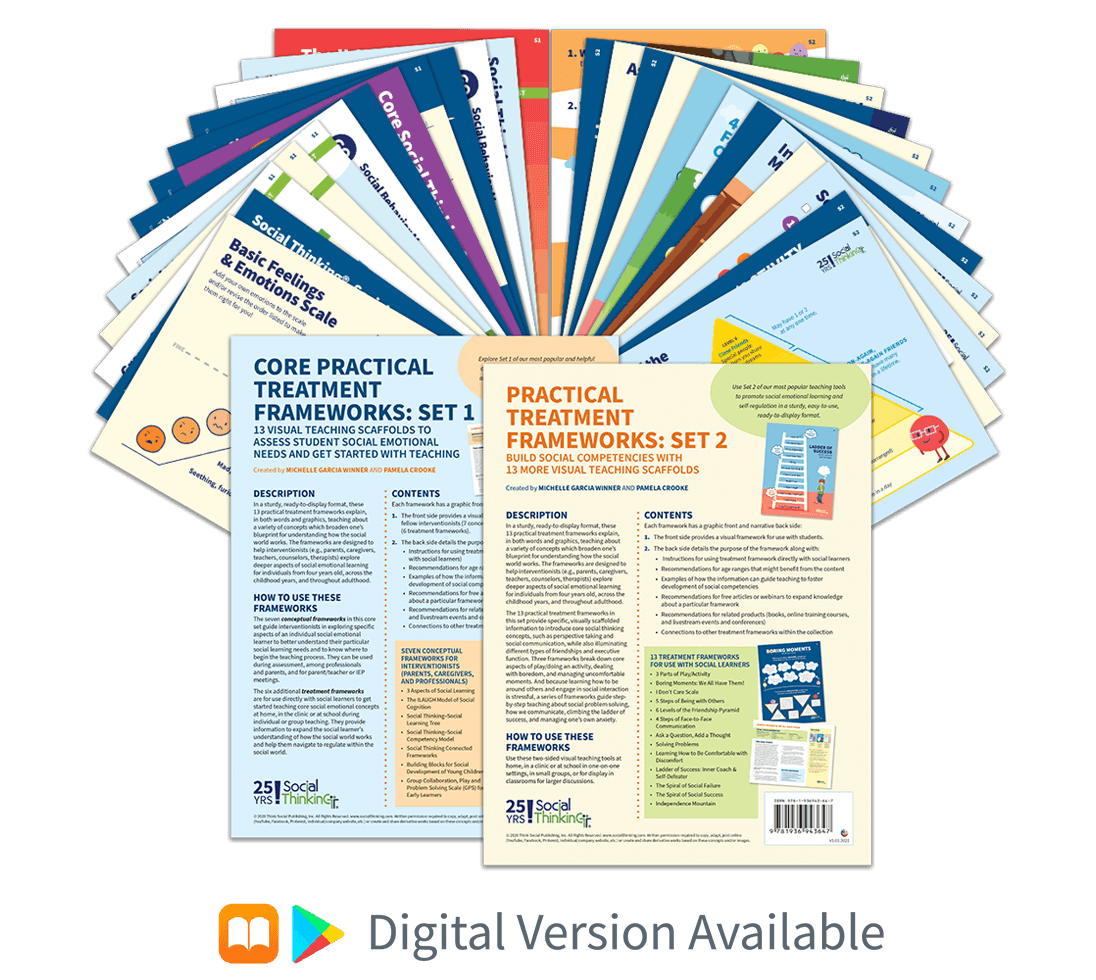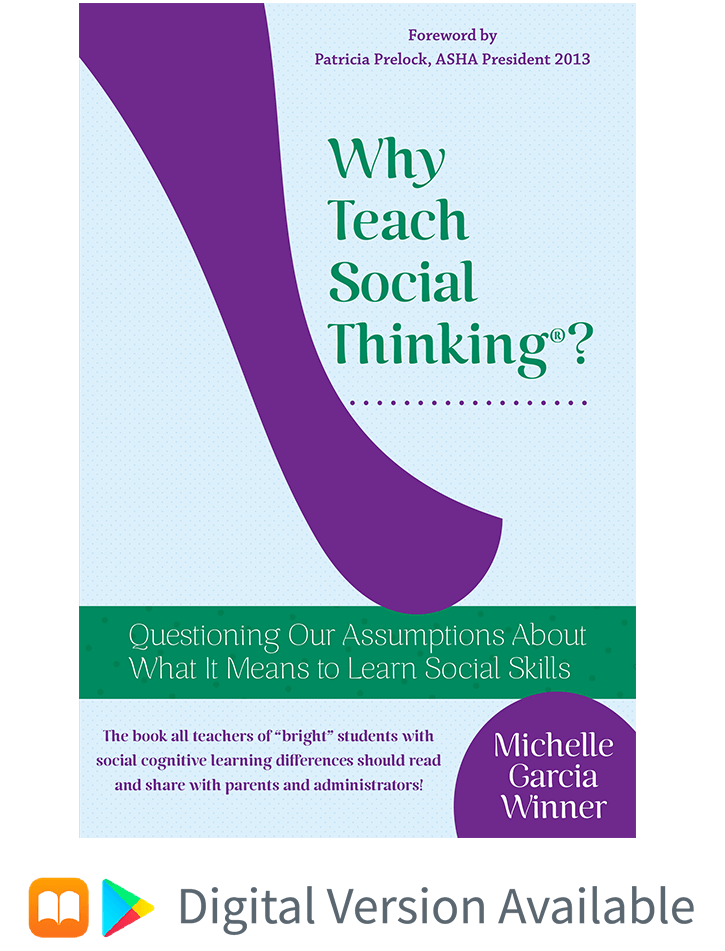Updated: April, 2022
© 2022 Think Social Publishing, Inc.
Why is writing so hard?
If you think about it, written expression requires motor planning, social thinking, organizational skills, spelling, grammar, and punctuation to all dance together simultaneously. If any one of these factors gets left out or is missed, the result is a poor writing sample. We also know from the literature that some kids have an associated struggle to multi-task or use effective executive function skills.
Many kids feel frustrated and angry about having to do something that completely overwhelms them. Some of the most explosive meltdowns or what some might call “behavior problems” are commonly associated with a request for the student to write. The outcomes of asking students to produce written language without the tools to do so is simply no fun, and can be upsetting and difficult for students, teachers, or parents.
How is social thinking (thinking socially) part of the written expression process?
By 3rd and 4th grade, students are learning to write for an audience, which means they need to adjust their own writing to help the reader understand their thoughts. This requires knowing that people have thoughts that are different from their own (perspective taking) as well as the ability to narrate a story across time and/or sequence so the reader can follow and make reasonable conclusions to avoid confusion (narrative language). Students are also expected to learn and understand that writing stories or retelling experiences usually moves from bigger ideas (gestalt or main idea) to thoughts (details). To help the reader, the writer has to organize their information to introduce the idea and then support it with a reasonable set of thoughts (details). There's also the issue of motor planning and visual perceptual struggles. And then, written expression doesn't usually just pour out of our brains and hands. We have to first think about what to write and how to structure it. Many use brainstorming or mind-mapping tools to organize and sort out main ideas from the related thoughts/details. However, if a student has difficulty staying focused and/or holding thoughts together, then their thinking can quickly become fragmented or tangential.
Older Students
There are endless stories of high school students who received years of specialized academic support, but still couldn't independently write a paragraph. They could complete written assignments IF the content was interesting to them, but the resulting text was mostly through their perspective. If support teams ruled out visual motor issues and the students “would not” or “could not” produce written assignments on demand, then they were thought of as a behavior problem. Interestingly, many of these students were able to pass district and state level written language testing when multiple choice questions focused on grammar, vocabulary, and structure. This is a great example of why we need to stop referring to this phenomenon as purely a "writing problem" and most certainly stop calling it a behavior problem. The reality is that the struggle to produce writing for others begins as a thinking problem. In schools, students who struggle with written expression often get a “referral” for specialized help. After an intensive focus on grammar, punctuation, spelling, and basic organization, they are then asked to prove their new knowledge by producing more written work. This just begins the meltdown cycle all over again.
The reality is that many students with social learning differences and/or challenges may have difficulty:
- Organizing their thinking to put it on paper,
- Putting their thoughts down in a cohesive manner,
- Demonstrating they are thinking about what other people are thinking to write in a manner that other readers can understand, and
- Recognizing how other people form their own thoughts and emotions.
All these concepts are at the core of written expression. Neurotypical students develop these intuitively and then practice through play, conversations, and written language.
How to help?
- Teach that recognizing and organizing one’s [social] thinking is a precursor for writing.
- Get away from thinking that negative emotions from the student during writing tasks are behavior problems. Or, that they are a ploy to avoid hard work. Consider instead that the student is communicating to you that something in the thinking/brainstorming/writing process is too difficult at that moment.
- Break down the writing process into lots of small steps.
- Teach how we think, or brainstorm information related to the topic. Most students (after 2nd grade) learn about "brainstorming" using "graphic organizers," "visual organizers," or "mind maps." Don’t rush this step.
- Teach the difference between ideas (main ideas) and how these are different from details. Teachers and clinicians might notice there are similar challenges in in conversational language which results in tangential comments that don’t connect to the main ideas of the conversations. Connect lines on the mind maps or brainstorming maps with different pen colors to show related ideas. Circle details to visually show they are different from main ideas.
- Work on helping them learn to prune their thoughts after brainstorming by creating written outlines to serve as guidance for their work. Or, if writing an outline is arduous, talk through the mind map to show there are main ideas and details that usually go together when writing the draft.
- Teach that a draft is simply that – a draft. Most writers don’t produce a final product on their first try. This is particularly difficult for students who tend to be perfectionists.
- For older students, teach the concept of an opinion and the importance of opinions in written language. We have seen many students who struggle with the idea of writing about only one side of an argument when they can see both sides. Or, being asked to write about one side of an argument that doesn't represent their thinking on the subject. This is in the academic standards, but it’s a perspective taking and social thinking task.
- Motivate students by giving credit, praise, for every part of the process, rather than just the product.
- Explore how written words impact how others think and feel as they read the essay.
Allowing thinking time away from writing time allows all students to participate in some part of the writing process without touching a pencil, pen, or keyboard. It also allows students to realize successes in small chunks and build confidence and knowledge in the foundations of writing before ever producing a product. But for those who believe that kids use tantrums to escape writing, we would ask you to consider how much time is spent dealing with emotions, behaviors, and learning disruptions related to writing. A writing problem is not just a writing problem. It is so much more complicated!












